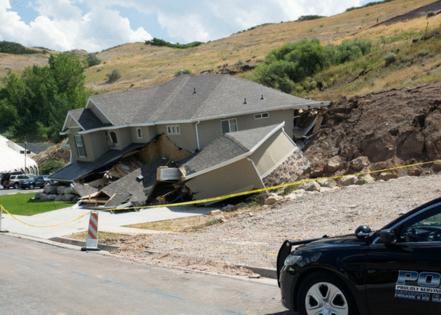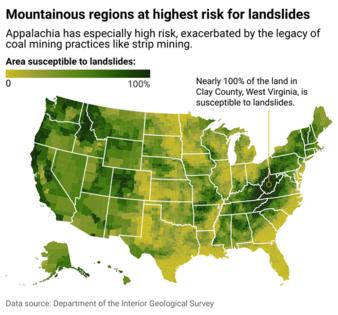Landslides are a threat to US infrastructure and safety. Here's where they pose the biggest threat.
Published in Slideshow World
Subscribe
Landslides are a threat to US infrastructure and safety. Here's where they pose the biggest threat.
Hurricane Helene wrought devastation across the Southeast. The storm's high winds and flooding killed more than 230 people, and the damage to property, infrastructure, and other economic impacts is estimated to be worth tens of billions of dollars.
But heavy rains and destructive winds weren't the only natural disasters out in force: The hurricane also activated nearly 2,000 landslides, of which over half have impacted roads, rivers, and structures, according to early estimates.
Even on their own, landslides are a deadly and costly natural disaster. There were 310 fatal landslides globally in the first half of 2024 alone, which killed 2,315 people—unusually high numbers compared to previous years. In the U.S., 25 to 50 people on average are killed by landslides each year, according to the Department of Interior.
Landslides from Hurricane Helene alone killed 20 people in North Carolina, which endured the worst of the storm's landslides. A combination of fast-moving mud and water destroyed roads, rail links, water access, homes, and businesses across the state.
As climate change strengthens hurricanes and increases the frequency and severity of extreme rain events, the risk of landslides is also rising. To get a clearer picture of where the risk is greatest, Truck Parking Club mapped county-level data from the Department of the Interior Geological Survey, published in September 2024. Counties are displayed by the share of their land area that is susceptible to landslides.
Visit thestacker.com for similar lists and stories.
Counties within mountain ranges have high landslide susceptibility
A landslide occurs when rock, debris, or earth moves down a slope. Inclines like hills and bluffs are a critical component of slides, meaning mountainous regions are at higher risk. Typically, landslides are triggered by other forces like heavy rainfall, snowmelt, earthquakes, volcanic activity, human activities, or some combination of factors. They're often impossible to predict.
According to the Geological Survey, places where weak or fractured earth materials sit on steep slopes are likely to experience landslides—for example, areas with a history of strip mining. In Appalachia, about 1,400 square miles of land are scarred by strip mining within the Ohio River basin, according to an Inside Climate News analysis of satellite imagery. Together, the "waste rock" left behind, increasing stream flows, and heavy rainfalls brought on by climate change create a deadly recipe for landslides. This part of Appalachia is also near the Gulf of Mexico, where fast-warming waters stir up exceptionally wet and fast-growing storms, as was the case with Hurricane Helene.
Combined, these elements create the highest vulnerability to landslides in the region. Much of West Virginia, in particular, is at risk: In 47 of the state's 55 counties, more than 90% of the land is susceptible to slides. Parts of Virginia, Kentucky, Ohio, Tennessee, and North Carolina are also exceedingly vulnerable.
The California coast has also been plagued by high-profile landslides. Earlier this year, a rockslide destroyed part of Highway 1 along the state's famed Big Sur. The earth below the highway isn't sturdy, and wetter storms are further weakening it and contributing to more frequent and severe landslides. It's an iconic road trip and tourism destination, where the highway winds along cliffs above the Pacific Ocean, but it was forced to close to most traffic and still offers just one lane of traffic at some points.
Other landslide risk factors include population growth, rapid land use changes, urbanization, heavy logging and deforestation, and inappropriate use of lands—slopes in particular. Wildfires also generate landslide hazards, leaving behind excess debris to get dragged down during floods, as Big Sur has experienced.
The heightened frequency and severity of landslides are a direct consequence of logging, mining, and climate change, with massive repercussions for safety and critical infrastructure in the U.S. and across the world.
Hazard maps like those from the Geological Survey are a tool that federal, state, and local governments can use to identify landslide vulnerabilities and prepare for them. Preparation and mitigation efforts might include landslide drills, evacuation plans, improved drainage systems, and slope stabilization. Governments in susceptible areas can adopt disaster-resilient building codes and standards, as well as restrictions on mining and logging.
In some cases, such as Highway 1, there are no conceivable solutions to fully protect against landslides. Still, with increased awareness and response plans, people can make more informed decisions on where to live (or safely visit) and can prepare themselves for landslides and their aftermath.
Story editing by Carren Jao. Additional editing by Kelly Glass. Copy editing by Tim Bruns.
This story originally appeared on Truck Parking Club and was produced and distributed in partnership with Stacker Studio.








Comments